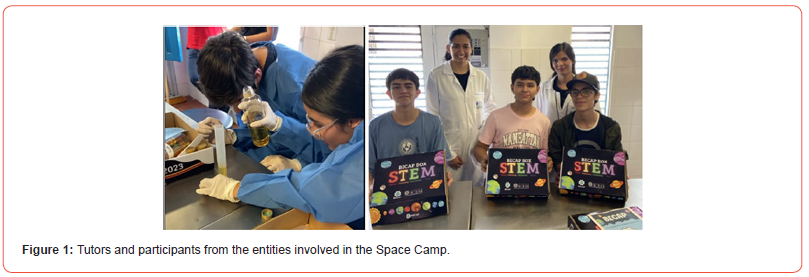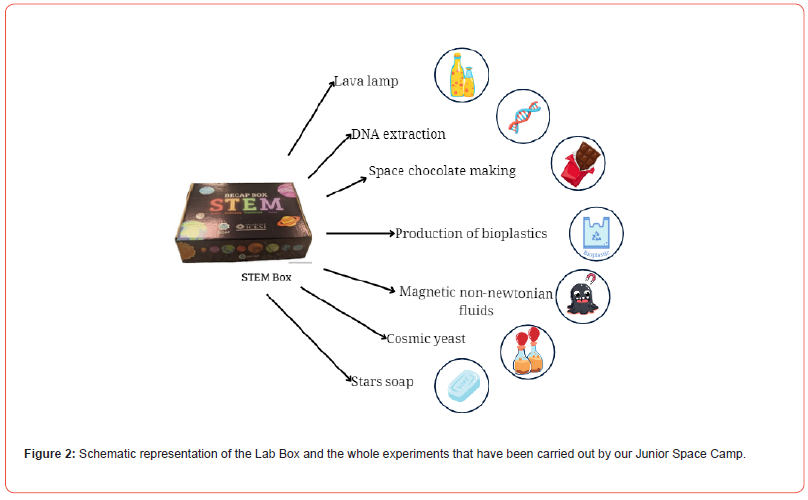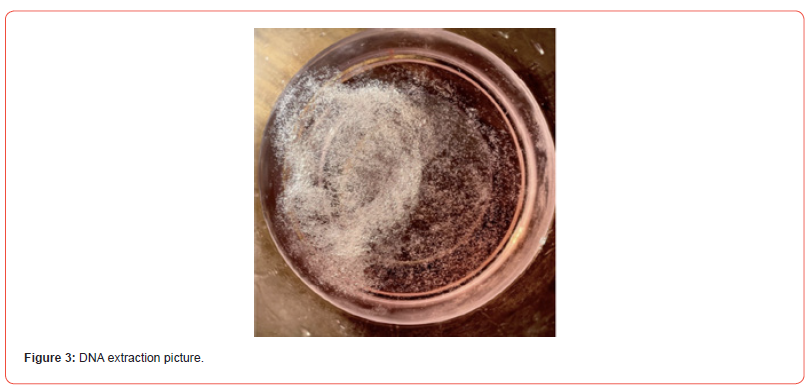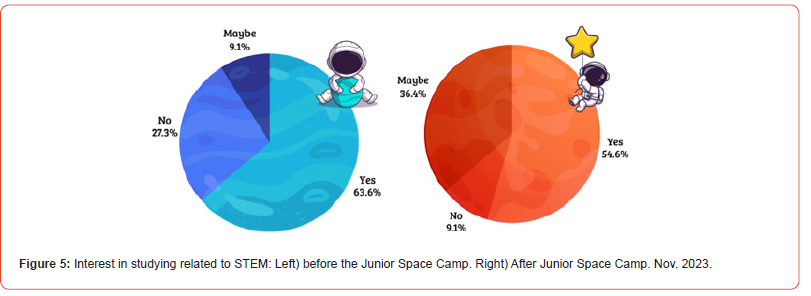 Mini Review
Mini Review
Forging a Space Camp Nexus Between Industry and Academia
Jose Dario Perea1,2,3*, Eduardo Arbeláez1, Angie N Lasprilla Pantoja1, Manuela M Bastidas1, Laura G Arango Arenas1, Juan D Corredor Rubio1, Juliana Bejarano Correa1, Mariana De Dios Collazos1, Monica Y.Jaramillo1, Estefania Rojas Rayo1, Melissa Valois Hernández1, Pablo A Amú1, Margarita R Castro1, Santiago Tamayo1, Karla E Orozco1, Carolina Posada4, Andres Felipe Giraldo4, Catalina Hoyos4, Liliana Restrepo4,and Carolina Orozco Donneys1,2*
1Departamento de Ingeniería Bioquímica, Universidad Icesi, Cali, Colombia
2Analog Astronaut Training Center, Krakow, Poland
3Cubes in Space, IEDU, Virginia Beach, USA
4Fundacion Frisby, Pereira, Colombia
Jose Dario Perea, Adjunct Professor at Universidad Icesi, Colombia, and Carolina Orozco Donneys, Program Director of the Biochemical Engineering Department at Universidad Icesi, Leader of the Becap Initiative, Colombia. More mation: https://www.canva.com/design/ DAFvdwPu0e8/7IP8ZDzvWFAbUzJzlhzbeg/edit.
Received Date:January 11, 2024; Published Date:January 30, 2024
Abstract
As part of an unprecedented collaboration between industry and academia, we launched an innovative STEM outreach project through a Junior Space Camp for the first time. The project broadens student interest in science, technology, engineering, and math (STEM) careers by focusing on biochemical processes with an emphasis on outer space. Under this model, we implemented a self-sustained lab box with videos illustrating the experiments via QR codes, an illustrative orientation manual, and a colloquium of analog astronauts in training. The students who participated in this Junior Space Camp came from the Instituto Tecnológico dos Quebradas Alfredo Hoyos Mazuera (ITD) of the Frisby Foundation. The juveniles in our programs typically come from rural areas of Colombia, with a high school education and a primary emphasis on materials science. Through this project, we also hope to inspire other students, especially those from Latin American countries where access to higher education can be a challenge, to pursue careers in STEM fields. The project also helped students cultivate their curiosity, strengthen their scientific skills, and increase their interest in STEM. The success of this project was made possible by an extraordinary collaborative network between an academic and a corporate entity. Within this project, we obtained an autonomous system and unique and innovative practices in outer space under a partnership with the Tachi Umada Analog Astronaut project.
Keywords:STEM; Space Camp; Outer Space; Biochemical Engineering; Science Outreach
Introduction
Establishing comprehensive STEM education initiatives nationally in low-to-middle-income countries is a challenging task requiring significant investments. However, integrating these strategies within existing educational systems presents challenges. Resource constraints, curriculum resistance, and social disparities are persistent hurdles in countries burdened by high poverty rates and inadequate infrastructure [1,2]. Consequently, achieving the goal of democratizing and widely embracing STEM education necessitates meticulous planning and targeted interventions to surmount these barriers [3]. Seeking innovative approaches to enhance STEM education in diverse rural regions of Colombia, we have established a collaborative network involving both public and private entities. Figure 1 shows the interaction between some of the participants and the tutors from the entities involved in our Junior Space Camp (Figure 1).

This united effort is focused on engaging middle and high school students, a demographic with immense potential for driving social transformation. Within this context, we introduce a methodology founded on collaboration among various organizations that bring together esteemed international scientific figures. Together, they facilitate cutting-edge scientific experiences replicating authentic laboratory settings in rural environments. In this way, the Colombian Ministry of Science and Technology attributes the underrepresentation of rural children (especially girls) in STEM disciplines to sociocultural barriers, such as parental influence, family environment, social discrimination, and ingrained prejudices and stereotypes prevalent in cultural and academic settings [4]. Concurrently, it is imperative to acknowledge the evolving concept of STEM, which has embraced diverse thinking spanning scientific and humanistic disciplines. This evolution empowers children and young adults to devise creative and innovative solutions to various challenges and activities [5]. This conceptual shift has given rise to numerous global initiatives that promote pedagogical and interactive activities. An exemplary illustration is the STEM Box Kits Experience, a project tailored for Puerto Rico’s children to enhance their design and critical thinking skills by exploring fundamental concepts related to electricity and renewable energy management through hands-on experimentation. Additionally, it is worth noting three of our prior initiatives, which involve STEM exploration and testing in near-outer space contexts [6-8].
In this vein, ventures like KiwiCo (American), StemBox (American), STEM Education Works (Australian), and National Geographic (American) have emerged, actively engaging with laboratory kits, and developing a spectrum of activities spanning geography, robotics, art, and STEM subjects. Several studies have been published assessing STEM challenges, particularly enhancing students’ skills from the 3rd grade onwards. Notable examples include research conducted by the University of Indonesia [9], a high school in Hong Kong [10], and a private school in Istanbul [11], all of which demonstrate significant improvements in critical thinking, problem-solving skills, and motivation within the studied subject areas.
Transitioning from High School to Outer Space Projects:
In recent times, space exploration has undergone a significant transformation due to rapid technological advancements. What was once the exclusive domain of powerful governments has transformed into a thriving commercial and academic activity driven by private sector initiatives [12,13]. According to research by the Massachusetts Institute of Technology Media Lab, among other institutions such as NASA Jet Propulsion - CALTECH, this shift offers unprecedented opportunities to engage a broader public in space exploration, which would be a true democratization of outer space. Consequently, as we prepare the next generation of space exploration professionals, it is imperative to strengthen STEM education initiatives globally. At the same time, space exploration-related educational programs such as CubeSats, Cubes in Space, Project Possum, and AATC-ESA provide a platform for underrepresented groups to indirectly participate in space exploration through experiments sent into outer space, local infrastructure limitations, and resource scarcity, which mainly affect students from low to middle-income countries. In our case, we approach these challenges carefully, recognizing the profound limitations of the rural settings where our outreach program is conducted.
Methodology
To foster a dynamic and engaging learning experience, we introduce a series of activities centered around a custom-designed laboratory box (LabBox) prepared by our team. Our endeavor is rooted in a strong commitment to inspire young minds, forging a link between their knowledge and the fascinating world of bioprocesses to outer space applications. To execute this vision, we have enlisted the guidance of accomplished Biochemical Engineering students from Icesi University’s Engineering Project Management course. Our collaborative effort is structured through specialized committees, each diligently contributing to the success of our educational initiative. These committees and their respective responsibilities are as follows:
Academic Committee: Comprising engineering students, this committee undertakes the vital task of curating and designing the practical exercises for the event day. They select individuals passionate about teaching and have a gift for effectively conveying complex ideas.
Marketing Committee: This dynamic team oversees the promotion and documentation of the event, skillfully managing our online presence. They are also entrusted with the meticulous design of the laboratory kit, ensuring that its dimensions accommodate all necessary components for the participants on the event day.
Logistics Committee: The logistical aspect of the event is orchestrated by this dedicated team, who meticulously craft and adhere to the event’s schedule. Additionally, they coordinate the deliveries of materials from other committees throughout the semester, ensuring an efficient workflow. This committee also secures venues for the activities and procures essential supplies.
Financial Committee: Comprised of students with financial acumen or those seeking to cultivate their expertise in this domain, this committee is charged with devising innovative financing strategies to support the event. Their creativity shines as they explore efficient funding avenues.
Relationship Committee: This committee plays a pivotal role in our initiative by establishing connections with potential sponsors and supporters of the Junior Space Camp project. Collaborating closely with the finance committee, they strategize ways to secure financial backing, engaging with companies interested in endorsing the event.
ITD School Committee: This committee consists of the school’s teachers and is responsible for orienting students and facilitating contact with the leaders of the Junior Space Camp. In close collaboration with the academic committee, they elaborate strategies to guarantee a good understanding of the workshops and a good working environment.
Together, these committees form a synergistic and empathetic unit to offer an enriching educational experience to all participants. It should be noted that each committee must maintain constant communication to develop the event properly. Descriptions of the practices and the expected impact on participants are indexed, followed by vital parameters considered for the project’s development, such as empathy and knowledge sharing based on the dialogue of knowledge and the reproducibility and impact of the project in the media, ending with its actual feasibility.
Results and Discussion
In this manuscript, we focus on the synergy between a collegestyle educational institution, a social science program with an emphasis on biochemical processes, and a group of astronaut analogs in training who lead a Junior Space Camp. In Figure 2, we can see our laboratory box (self-designed), which illustrates the experiments performed in the workshop and later performed by the students without the help of mentors. We want to emphasize that these practices are exclusive of biochemical processes with an emphasis of outer space exploration and extend to an exchange of knowledge from ancestry to the new STEM knowledge, away from the idea of making robotics a single element of STEM (Figure 2).

Empowering children to participate in outer space projects:
Encouraging children’s participation and motivation in STEM careers is crucial. Providing them with the tools and opportunities to explore their potential can inspire and empower them to inquire about science and technology careers. One innovative proposal that combines biochemical engineering and potential outer space applications can promote a sense of belonging and connection to cultural heritage. It can also open doors to exciting and creative possibilities in the STEM field. This powerful combination can awaken their curiosity and offer a unique and valuable perspective.
Consequently, it can create a new generation of STEM leaders with a solid scientific foundation. Advanced technology, growing international collaboration, and decreasing costs have opened the doors of space to diverse actors, from start-ups to educational communities to enthusiastic citizens. This democratization not only means more equitable access to space exploration but also offers unprecedented opportunities to develop innovative solutions and generate collective knowledge.
The convergence of STEM and outer space promises to transform our societies, inspiring young minds, promoting global collaboration, and opening up a vast horizon of scientific discovery and breakthroughs. As we move toward an era in which space becomes a common ground for humanity, the democratization of STEM and access to outer space stand as fundamental pillars for an inclusive, inspiring, and possibility-filled future (Figure 3).

Our synergistic Junior Space Camp aims to teach students about the possibilities of bioprocessing and STEM. Collaboration with NASA partner Cubes in Space has enabled students to participate in space exploration and contribute to technological innovation. This cooperation has made space research more affordable and accessible. Additionally, two crew members lead the group of analogous astronauts in training for the European AATC program. This democratization of outer space has the potential to promote innovation, scientific discovery, and economic growth while fostering international cooperation and collaboration. Below is a brief description of the experiments:
Table 1:

Our Junior Space Camp also began with a Talk and Colloquium:
Table 2:


Measuring the Impact of Our Methodology
This project has had several iterations since its origins 3 years ago, the original idea being to impact girls from Afro-indigenous communities to encourage the participation of women in the STEM area through the activities and practices contained in the lab box. Over the years, the practices contained in the box have been varied with the intention of perfecting the methodology used to reach the participants from an empathetic approach, also seeking to enhance the scope of the project and make it more attractive to young audiences. This empathetic approach has been a key asset at the time of realizing the practices, since the tutors in charge can establish links with the assistants that eventually favor the exchange of knowledge between them. This dialogue of knowledge was especially crucial during the first iterations as it focused on Afro-indigenous communities, since it allowed the tutors to expand their awareness of the ancestral knowledge that permeates Colombia and thus improve the connection between science and ancestry manifested in each practice, making the children see that science is not something unknown, but has been used and improved since the beginning of time by humanity to carry out a wide range of processes.
In addition, over time the project has been expanding its scope, focusing not only on encouraging female participation but also on any child interested in taking it. This has allowed us to propose practices that favor the autonomy of the box, where, with the help of videos previously created by the tutors, each and every one of the experiences proposed can be carried out from the comfort of home. For the moment, in order not to lose the key factor of empathy during the course of the project, half of the practices are carried out with the children. This is intended to ensure an adequate absorption of the knowledge provided, to explain how the box works and how to use the materials contained inside it to carry out autonomous experiments. Nowadays, the project has escalated from being always carried out in university facilities with laboratory implements to taking place in schools along different cities of Colombia, simplifying the implements required to carry out the practices and gradually easing new enjoyable ways of learning.
The collaboration with different companies throughout the life cycle of the project has also allowed the approach to STEM careers to be more than just a dream for the children. This is achieved through the implementation of scholarships so that some of the participants can access higher education institutions as long as they show a high interest in STEM-related careers and a high performance during the days with the tutors. Also, complementing the project with a Space Camp with analogous astronauts has proven to awaken the interest of young people by making outer space accessible to all, establishing a link between science, space and ancestry wisdom, thus providing participants with knowledge about the democratization of outer space. Next, in figure 5, we can observe the STEM interest before and after the Junior Space Camp took place:

This figure enhances the discussion about the significance and the impact of these sessions, as particularly in this section, we also want to show the results of our synergic initiative and how it has impacted motivation, learning, the pursuit of opportunities, and funding for girls from ethnic communities. Prof. Carolina Orozco Donneys and Prof. Dr. Jose Dario Perea led the whole project. However, its approach transcends academic boundaries, as it is taught under an independent model, thus marking a milestone in promoting equity and inclusion. Surveys and end-of-program informational interviews have shown that a good number of middle and highschool students participating in our outreach initiatives end up particularly interested in pursuing careers in different STEM fields. So far, some students have initiated a collaborative project in biochemical engineering with ICESI University, which offers a promising future for today’s world that depends on technological advances and biochemical transformation processes to be applied in outer space.
For high school students, Space Camp is an exciting challenge that tests the knowledge they have acquired throughout their academic training. This is because they must transition from technical to more accessible and understandable language for a younger audience. In this way, the face-to-face activities of the laboratory box allow middle school students to be receptive to knowledge, as the close age difference between these two population groups creates empathy ties.
Conclusions
In conclusion, our initiative has proven to be a hope in promoting quality STEM education, catalyzing a genuine democratization of science, engineering, and, surprisingly, even outer space. Our results highlight the power of cutting-edge research to reach into decentralized sectors of society and achieve remarkable results. Through meticulous planning and execution of experiments outside the traditional laboratory setting, we have achieved excellent synergy between the biochemical aspects and the external space between academia and an entrepreneurial model institute of the Frisby Foundation.
Our effort has been bolstered by the unwavering support of dedicated academics, including faculty and graduate students, who share our vision of democratizing science and outer space to catalyze social change. Their invaluable contributions have given momentum to our project, enabling the inclusion of new stakeholders and the continued propagation of our methodology.
In essence, our project embodies a collaborative approach, which not only advances STEM education in underserved rural regions, where the need is most pronounced but also nurtures a scientific culture within diverse communities and regions. Our aspiration is that, in the not-too-distant future, students who have benefited from these programs will, in turn, be catalysts for sustainable development in their communities.
Author Contributions
J.D.P and C.O.D originated the project, led the initiative, supervised the experiments, and wrote the article with the active participation of the management course students. The manuscript was written through contributions of all authors. All authors have given approval to the final version of the manuscript.
Notes
The authors declare no competing financial interest.
Acknowledgments
The authors would like to express their sincere gratitude to the following organizations for their valuable support: Universidad Icesi, Cubes in Space, NASA. The authors would also like to acknowledge the invaluable contribution of all the Icesi monitors who served as mentors to the kids involved in this project. Lastly, J.D.P. and C.O.D. sincerely thank Tecnoquimicas, Celsia, Madoco XXI, and Fundacion Frisby for their invaluable support under the Tachi Umada.
Conflict of Interest
No conflict of interest.
References
- Lamidi ES, Adeagbo AA (2019) Challenges and Opportunities for Science Education in Low-Income Countries. Research in Science Education.
- Subramanya MSR, Tyagi RS (2016) Science Education in Developing Countries: Issues and Perspectives for Planning and Policy. Current Science.
- Savage N (2018) Expanding the reach of science. Nature 562(S11).
- Morales Inga S, Morales Tristán O (2020) ¿Por qué hay pocas mujeres científicas? Una revisión de literatura sobre la brecha de género en carreras STEM. aDResearch ESIC 22(22): 118-133.
- Wahyuningsih S, Nurjanah N, Endang U, Hafidah R, Pudyaningtyas A, et al. (2020) STEAM Learning in Early Childhood Education: A Literature Review. International Journal of Pedagogy and Teacher Education 4(1): 33.
- Perea JD et al. (2021) Last Generation Solar Cells in Outer Space: A STEM Outreach Project with Middle and High School Stundents in Colombia. European Journal of STEM Education 6(1): 12.
- Bustamante, et al. (2021) Teach Lunar Toilet: A STEM Project with High School Students. European Journal of STEM Education 6(1): 12.
- Orozco C, Perea JD (2022) Empowering Afro-Indigenous girls. Science 375(6582): 730.
- Erry A, Rahmawati Y, Marciah A (2020) STEAM-Project-Based Learning Integration to Improve Elementary School Students' Scientific Literacy on Alternative Energy Learning. Universal Journal of Educational Research 8(5): 1863-1873.
- Chung SK, Li D (2021) Issues-Based STEAM education: A case study in a Hong Kong secondary school. International Journal of Education & the Arts 22(3).
- Asigigan SI, Samur Y (2021) The effect of gamified STEM practices on students’ intrinsic motivation, critical thinking disposition levels, and perception of problem-solving skills. International Journal of Education in Mathematics, Science, and Technology (IJEMST) 9(2): 332-352.
- Bugga RV, Brandon EJ (2020) Energy Storage for the Next Generation of Robotic Space Exploration. The Electrochemical Society Interface 29(1): 59.
- Ackerman E (2020) GITAI Sending Autonomous Robot to Space Station.
-
Jose Dario Perea*, Eduardo Arbeláez, Angie N Lasprilla Pantoja, Manuela M Bastidas and Laura G Arango Arenas etc all... Forging a Space Camp Nexus Between Industry and Academia. Iris J of Edu & Res. 2(2): 2024. IJER.MS.ID.000535.
-
STEM, Space Camp, Outer Space, Biochemical Engineering, Science Outreach
-

This work is licensed under a Creative Commons Attribution-NonCommercial 4.0 International License.






